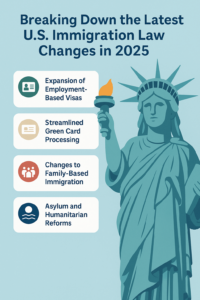“Latest immigration law changes in the US 2025”
Detailed Analysis of the Most Recent 2025 Amendments to US Immigration Law
 The United States’ immigration laws are continually changing, and 2025 has brought about several significant shifts that affect employers, attorneys, and immigrants nationwide. Anybody involved in U.S. immigration must be updated about these immigration reforms, which are intended to improve border security, alleviate labor shortages, and expedite the legal system. We’ll look at the most recent revisions to the immigration laws for 2025, their effects on different visa categories, the main policy changes, and the implications for international students, families, and workers in this extensive guide.
The United States’ immigration laws are continually changing, and 2025 has brought about several significant shifts that affect employers, attorneys, and immigrants nationwide. Anybody involved in U.S. immigration must be updated about these immigration reforms, which are intended to improve border security, alleviate labor shortages, and expedite the legal system. We’ll look at the most recent revisions to the immigration laws for 2025, their effects on different visa categories, the main policy changes, and the implications for international students, families, and workers in this extensive guide.
A look at the changes to U.S. immigration laws in 2025
The Biden administration has implemented several legislative and administrative changes in early 2025 as part of its ongoing immigration reform agenda. By modernizing the immigration system, these modifications seek to strike a balance between economic expansion, humanitarian obligations, and national security.
The new immigration laws’ top priorities are as follows:
- lowering the backlog of green cards.
- Increasing visa availability in industries with strong demand.
- Improving asylum seekers’ protections.
- putting in place processing systems with greater speed and transparency.
More types of employment-based visas are available.
The development of employment-based visa programs, particularly for high-demand sectors like technology, healthcare, and renewable energy, is one of the most significant trends in 2025.
A higher cap on H-1B visas.
The H-1B visa quota was increased from 85,000 to 120,000 each year, with an extra 20,000 set aside for those with advanced degrees from American universities. This raise aims to draw in top talent from around the world and addresses the persistent labor shortage in STEM disciplines.
The new STEM Talent Visa.
Foreign graduates with advanced degrees in science, technology, engineering, or mathematics can apply straight for permanent residency without employer sponsorship, according to a recently announced “STEM Talent Visa.” High-skilled professionals now have a clearer route to permanent immigration thanks to this move.
Green Card Processing and Backlog Reduction
Simplified Procedures for Green Cards.
In order to process green card applications more quickly, the U.S. Citizenship and Immigration Services (USCIS) has introduced new digital platforms and AI-supported tools. It is anticipated that processing times may drop by as much as 40% from prior years.
Removal of Per-Country Restrictions.
In order to assist applicants from nations like China and India who have traditionally had to wait a long time, legislation has eliminated the per-country restrictions on employment-based green cards. This important change encourages a fairer allocation of visas.
Modifications to Immigration Based on Family
Quicker Reunification of Families
The family-sponsored visa procedure has been updated to include shorter wait times for close family members and more openness about processing schedules. All petitions from immediate relatives will be processed by USCIS within a year.
Digital Family Visa Applications
For family-based visa categories, a fully digital application system has been implemented, enabling applicants to get quicker updates and check the status of their cases in real time.
Reforms to Humanitarian and Asylum Programs.
Better Processing of Asylums.
For those escaping persecution, a new “Asylum Fast-Track Program” expedites credible fear interviews and asylum applications. This seeks to maintain due process rights while lowering backlogs.
Protections for Refugees from Climate Change.
The United States has officially acknowledged climate displacement as a foundation for humanitarian protection for the first time. According to updated standards, those who have been displaced by environmental disasters are now eligible for temporary protected status (TPS).
Improvements to border security and enforcement.
Intelligent Border Technologies.
The goal of investments in AI-assisted monitoring and cutting-edge surveillance technologies at the U.S.-Mexico border is to enhance border security without exclusively depending on physical barriers. These consist of real-time data analytics and biometric tracking technologies.
Updated Priorities for Deportations.
A new set of objectives has been adopted by ICE, with a focus on serious criminal offenses and national security threats. Deprioritizing low-level, non-violent immigration offenses frees up resources for high-risk cases.
International Students and Education-Based Visas.
Expanded OPT and CPT Options
Optional Practical Training (OPT) and Curricular Practical Training (CPT) regulations have been expanded to include more degree programs and longer eligibility periods. This change allows international students to gain valuable U.S. work experience before transitioning to a work visa or permanent residency.
Visa Cap Exemption for U.S. Graduates
A new policy allows international graduates of U.S. universities who secure a job offer in their field to bypass certain annual visa caps. This incentive encourages foreign students to remain in the U.S. workforce.
Digital Transformation of USCIS and Immigration Services
The Department of Homeland Security has committed to a full digital transformation of immigration services by the end of 2025. Key features of this transformation include:
-
AI-powered application screening
-
Real-time application tracking
-
Mobile-friendly platforms for all immigration forms
-
Increased transparency and fewer administrative errors
This digital evolution is expected to improve user experience, minimize processing delays, and provide faster resolutions for applicants.
In conclusion, what do these changes to the immigration law mean for you?
A significant step toward a more contemporary, effective, and compassionate immigration system is represented by the 2025 amendments to U.S. immigration law. These revisions are intended to give clearer pathways and lessen ambiguity, regardless of whether you are an international professional, a family member looking for reunification, or an asylum seeker.
But like any legal reform, it’s important to keep yourself updated and speak with a knowledgeable immigration lawyer to find out how these rules relate to your particular situation.

